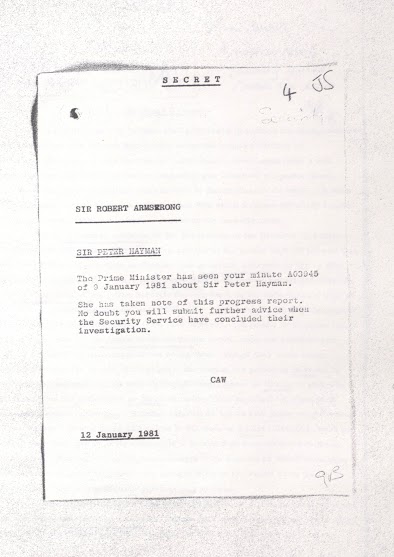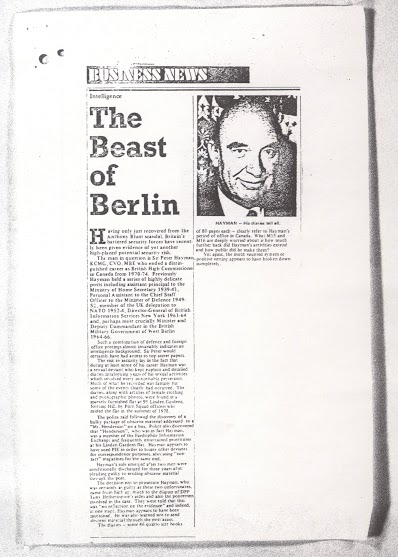The File on Peter Hayman in the National Archives
Posted: January 30, 2015 Filed under: Abuse, History, PIE | Tags: national archives, peter hayman, tom symonds 12 CommentsWith great thanks to Tom Symonds for forwarding these files to me.
The following is the complete file in the National Archives, PREM 19/588, ‘SECURITY. Sir Peter Hayman: allegations against former public official of unnatural sexual proclivities; security aspects’, which was made public today. Hayman was a senior diplomat and member of the Paedophile Information Exchange who is also believed to have been Deputy Director of MI6. For reports on this, see those from the BBC, Sky News, Guardian Independent, Telegraph, Mail and Mirror.
I will post further links relating to Hayman later; for now, I would recommend strongly people read this collection of articles at the Spotlight blog. Also of great importance are the most recent articles from Exaro here, here and here.






































Just to say, although it now says everywhere that Hayman was “Deputy Director of MI6”, anyone who knows how the Diplomatic Service works knows this can’t have been true. Indeed the names of the SIS deputy directors for the relevant period are known and available through open sources, so it is a little surprising that this has circulated without correction for so many months.
As far as I can tell, the claim was first published in a short item in the Guardian, which was however not written by one of the Guardian staff who knows about such things. So I suspect it may just have been a misunderstanding (I can’t comment on what work Hayman may or may not have done for, for example, MI5 or the MOD as I just don’t know) and this has since simply been copied by everyone else.
The Exaro website gave the claim wide publicity in the autumn so I wrote to them with more information but they did not reply (their articles are still available, uncorrected, or at least were when I last checked). When I posted a short clarification on their website it was removed, which has led me to doubt the journalistic seriousness of the Exaro operation.
That Hayman was both a senior diplomat and interested in paedophlia is undisputed. But the MI6 deputy claim is wrong.
Many thanks for this. I had been wondering again about the basis for the claim that Hayman was MI6 Deputy Director, but this seems to clear the matter up. Will draw attention to your comment.
It’s worth noting that the no.2 position in MI6 in the 1970s, held by Oldfield was Deputy Chief of the Secret Service. There would have been several Deputy Directors within given directorates, much as with Peter Wright’s famous position as ‘former assistant director of MI5’ which appeared on the dust-jacket of Spycatcher.
There was also a senior MI6 position of Foreign Office Advisor which could have been held by a diplomat like Hayman. I have uploaded an organogram of MI6 structure in 1977 from Philip H.J. Davies book here: https://twitter.com/tcgriffin/status/531534051447173120/photo/1
The statement in the Hayman file that he didn’t have an intelligence background obviously counts against any of these possibilities but it’s also worth noting what appears to be a redacted word in Armstrong’s note of 9/01/81 re interviews with ‘FCO and [..] officials’ who were colleagues of Hayman from 1959. Could the missing word be MI6 or, more, likely SIS?
All of that said, it may well be that the MI6 claim is straighforwardly wrong.
I think the issue of Hayman’s precise designation in ‘6 is a slight red herring. He liked titles. His postings were ‘6 postings and just as he styled himself, at least internally, as a Brigadier General, the correct military title for his post in Berlin. I think Tom has it about right
But if Hayman was a regular MI6 officer under diplomatic cover could Armstrong really gave told Thatcher that he didn’t have an intelligence background?
Tom, I think Armstrong was into a bit of bog standard back covering. He was the PS at the Home Office in 1978. It is fairly inconceivable that ‘5 did not warn their bosses what the Obscene Publications had passed to Special Branch, who would have automatically passed it to ‘5 who would, unless the system was being run as badly as the files imply, have notified the PS. We may find that all is not what it seems as things develop
Have just done a search for ‘Peter Hayman’ & ‘MI6’ on Nexis. The earliest sources for the claim I can find are from 2013.
Keir Mudie ;Nick Dorman, WAS IT COVER-UP?; The People, February 10, 2013.
..A police investigation found vile correspondence between Sir Peter and several other people.
But no prosecution was brought against the diplomat, who worked for MI6 and was High Commissioner to Canada…
Martin Hickman, Tory MP warned of powerful paedophile ring 30 years ago, The Independent (London), February 23, 2013 Saturday
…In 1981 Dickens had used Parliamentary privilege to name a diplomat and MI6 operative, Sir Peter Hayman as a pederast and demanded the Attorney General explain why he had escaped prosecution over the discovery of violent pornography on a London bus two years previously…
That said, for a diplomat like Hayman the inference from the original Private Eye’s story’s suggestion of an intelligence background probably always implied MI6.
[…] over the past week. The PREM 19/588 files released by the National Archives can be seen on the blog of Ian Pace and Spotlight on Abuse; both of which provide substantial resources on historical child-sex offence […]
[…] The File on Peter Hayman in the National Archives […]
Just a couple more thoughts on the above. Does Mrs. Thatcher’s banning (on the advice of Bernard Ingham) of the Attorney-General ‘s holding a press conference count as a cover-up?
Also, it would be interesting to know what exactly the “incident” in Baghdad in 1959-60 involved.
[…] The File on Peter Hayman in the National Archives (30/1/15) […]